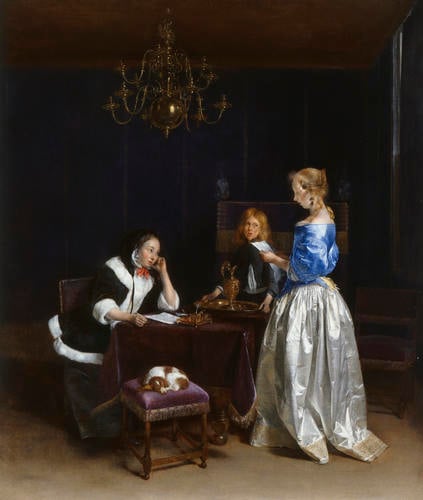-
1 of 253523 objects
The Letter c.1660-65
Oil on canvas | 81.9 x 68.4 x 12.0 cm (support, canvas/panel/stretcher external) | RCIN 405532

Gerard ter Borch (Zwolle 1617-Deventer 1681)
The Letter c.1660-65
-
The Dutch painter Gerard ter Borch is best known for his tranquil genre scenes mostly painted in the Dutch town of Deventer. He was one of three children, all of whom were trained by their father (also an artist) and pursued artistic careers. Here the boy has much in common with portraits of Gerard's half-brother Moses, while the woman reading the letter may be the artist's step-sister Gesina ter Borch.
The simplicity of this domestic scene encourages the viewer to delight in the beauty and detail of the objects that it contains. The interaction between the three participants is left open to interpretation and the significance of the letter is not explained. Ter Borch delights in metallic surfaces, for instance the reflections in the candelabrum and the inkwell and stand. The use of deep blue ultramarine edging around the woman's neckline and the rendering of the embroidery around the edge of her skirt are masterly touches. Similarly, the painting of the woman's silk skirt, which is in excellent condition, is a passage of mesmerising beauty.
At the end of the eighteenth century The Letter belonged to the Amsterdam merchant and art collector Jan Gildemeester. In the painting of his art gallery by Adriaan de Lelie (Amsterdam, Rijksmuseum), The Letter can clearly be seen hanging on the left-hand wall. This is one of two paintings by Ter Borch in the Royal Collection, both of which were purchased by George IV, an enthusiastic collector of the work of seventeenth-century Dutch masters.
Traces of a signature are visible on the letter under high magnification
Catalogue entry from Royal Treasures, A Golden Jubilee Celebration, London 2002Provenance
Beaujon sale, Paris, 25 April 1787 (25); bought by Dubois; Jan Gildemeester (Amsterdam), by c.1800; his sale, 11 June 1800 (28); Heathcote sale, London, 5 April 1805 (42); bought for Sir Francis Baring; Sir Thomas Baring; from whom bought by George IV, 1814 (no 45 out of the 86 Dutch and Flemish paintings); recorded in the Dining Room at Carlton House in 1819 (no 67); in the Picture Gallery at Buckingham Palace in 1841 (no 46)
-
Medium and techniques
Oil on canvas
Measurements
81.9 x 68.4 x 12.0 cm (support, canvas/panel/stretcher external)
102.5 x 90.2 x 12.0 cm (frame, external)
Other number(s)